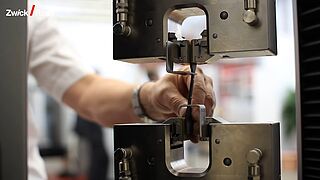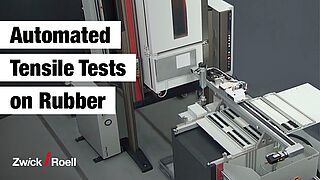ASTM D412 Tensile Test on Rubber and Elastomers
The ASTM D412 standard defines procedures used to evaluate the tensile (tension) properties of vulcanized thermoset rubber and thermoplastic elastomers. These materials are used every day in a variety of industries, including aerospace, medical, automotive, construction and more.
- Thermoset rubber is cured and set into a shape through heat application. Curing is an irreversible chemical reaction, which makes thermoset rubber products stronger and more durable. Products made of thermoset rubbers include tires, hockey pucks, circuit breakers, electrical housing, and motor components.
- Thermoplastic elastomers (TPE) are polymers, polymer blends or compounds. They normally begin in pellet form, become liquid when heated, and can then be injected into a mold, for example. The thermoplastic takes shape as it cools and hardens. This process can be reversed by re-heating the material. TPE applications include drive belts, shock absorbers, breathing tubes, catheters, and shoe soles.
Test objective Test performance and characteristic values Test equipment requirements Testing systems Automation
Objective of the tensile test on elastomers according to ASTM D412
- ASTM D412 provides specifications for the testing machine, the test specimens (including shape and size), and for the test procedure and appropriate methods to be used.
- The objective of the test is to determine various material characteristic values, which can then be used in the development of new products, in meeting product performance goals, or for research and quality control.
Performing the test according to ASTM D412
The ASTM D412 standard covers two test methods: Method A and B.
- Method A is based on dumbbell and straight section specimens, while Method B is based on cut ring specimens.
- Tests according to ASTM D412 are used to measure the elasticity of a material under tensile load, as well as the materials behavior after the test, when the load has been removed.
- The test is performed using a universal testing machine (also referred to as tensile testing machine) at a speed of 500 ± 50 mm/min, until the specimen fails.
While ASTM D412 is used to measure many different tensile properties, the most important characteristic values include the following:
Characteristic values determined according to ASTM D412
Definitions according to ASTM D1566 - Terminology Relating to Rubber
- Tensile stress: stress applied to stretch a specimen
- Tensile stress at a given elongation: stress required to stretch the uniform cross section of a test specimen to a given elongation
- Tensile strength: maximum tensile stress applied while stretching a specimen to the point of rupture
- Yield point: the point in the stress-strain curve, short of ultimate failure, where the rate of stress with respect to strain goes through a zero value and may become negative
- Ultimate elongation: the elongation at the time of rupture
- Tensile set: extension remaining after a specimen has been stretched then allowed to retract in a specified manner, expressed as a percentage of the original length
For detailed information and standard procedures, please refer to the ASTM D412 standard.
Specimens and dimensions in accordance with ASTM D412
- For the tensile test on rubber and elastomers, ASTM D412 specifies six types of dumbbell specimens and two types of cut ring specimens.
- The most commonly used specimen is a C-shape dumbbell specimen (ASTM D412 Type C) with an overall length of 115 mm (4.5 inches), gauge length of 25 mm (1 inch), measurement width of 6 mm (0.25 inches) and thickness of 3 mm. Three measurements must be made of the thickness, whereby the median of the three measurements is used as the thickness in calculating the cross sectional area.
| Standard | Type | Note | l3 mm | l1 mm | b2 mm | b1 mm | h mm | L0 mm | Shape |
|---|---|---|---|---|---|---|---|---|---|
| ASTM D412 | C | Preferred specimen | ≥115 | 33 | 25±1 | 6+0.05 | 1.3 ... 3.3 | 25±0.25 | Dumbbell specimen |
| ASTM D412 | A | Possible dimensions | ≥140 | 59±2 | 25±1 | 12+0.05 | 1.3 ... 3.3 | 50±0.5 | Dumbbell specimen |
| ASTM D412 | B | Possible dimensions | ≥40 | 59±2 | 25±1 | 6+0.05 | 1.3 ... 3.3 | 50±0.5 | Dumbbell specimen |
| ASTM D412 | D | Possible dimensions | ≥100 | 33±2 | 16±1 | 3+0.05 | 1.3 ... 3.3 | 25±0.25 | Dumbbell specimen |
| ASTM D412 | E | Possible dimensions | ≥125 | 59±2 | 16±1 | 3+0.05 | 1.3 ... 3.3 | 50±0.5 | Dumbbell specimen |
| ASTM D412 | F | Possible dimensions | ≥125 | 59±2 | 16±1 | 6+0.05 | 1.3 ... 3.3 | 50±0.5 | Dumbbell specimen |
| ASTM D412 | 1 | Preferred dimensions | 17.9 | 15.9 | 1 ... 3.3 | 50 | Ring specimen | ||
| ASTM D412 | 2 | Larger dimension | 35.8 | 31.8 | 1 ... 3.3 | 100 | Ring specimen |
Elastomer testing challenges
- Specimen gripping: as the specimen is stretched it becomes thinner and prone to slip out of the gripping area. The specimen grip to be used must be able to maintain a constant gripping force as the specimen shrinks.
- Specimen elongation: as the length of the specimen increases, the travel distance of the crosshead must be long enough—and therefore, the load frame tall enough—to accommodate the extended length of the specimen up to the point of break.
Testing machines
- zwickiLine materials testing machine – space-saving solutions for small test loads up to 5 kN and with a test range of up to 1365 mm
- ProLine materials testing machine for standardized tests and simple applications with a test area height from 1050 mm to 1450 mm
- AllroundLine materials testing machine – customizable and highly versatile with a test area height from 1030 mm to 2560 mm
Specimen grips
- Pneumatic grips : the gripping force is generated by pneumatic actuators. Gripping force independent of the tensile force ensures a constant gripping force over the course of the entire test sequence. For specimens prone to shrinkage, the gripping force is uniformly maintained by constant pneumatic pressure.
- Pincer grip : double actuator. The gripping force is increased proportionally by the pincer principle as the tensile force increases. This ensures automatic retightening for specimens prone to shrinkage.
Extensometers
- Longstroke: very large measurement travel and very high resolution over the entire measurement range. The solid mechanical design of the guide elements ensures reliable functionality even with specimens that show a whiplash effect at break.
- multiXtens II HP: fully automated and maximum precision throughout the entire measurement travel range Transmission of measurement, control, and status signals between the measurement carriages, measuring heads, and central measurement and control unit are handled by the extensometer’s microprocessor system.
- lightXtens: specially designed for highly elastic and contact-sensitive materials Ideal for specimens with high fracture energy and prone to whipping at break, which might damage mechanical, contact measuring systems.
Automated tensile tests in accordance with ASTM D412
Tensile tests on rubber and elastomers to ASTM D412 can also be automated.
The compact robotic testing system roboTest L can test up to 350 specimens automatically. A thickness measuring device integrated in the system measures the specimen thickness with accuracy and reproducibility.
The specimen gripper places the specimen in the testing machine and the tensile test according to ASTM D412 is started automatically. After the test, separate disposal grippers remove the specimen remains from the specimen grips.
The robotic testing system roboTest R is more complex and allows you to connect additional devices such as a specimen marking station, a centering station or a temperature chamber for accurate tempering of the specimen. The magazine capacity of the robotic testing system can also be expanded as needed.
If you have any questions regarding your testing requirements or challenges around ASTM D412, please feel free to contact our experts.
We look forward to discussing your needs.
Contact us
Frequently asked questions regarding ASTM D412
The ASTM D412 standard defines procedures used to evaluate the tensile (tension) properties of vulcanized thermoset rubber and thermoplastic elastomers. These tests are critical for determining the mechanical properties of rubber and elastomer materials, which in turn is important for product development, quality assurance and performance testing in a variety of industries, including aerospace, medical, automotive, construction, and more.






